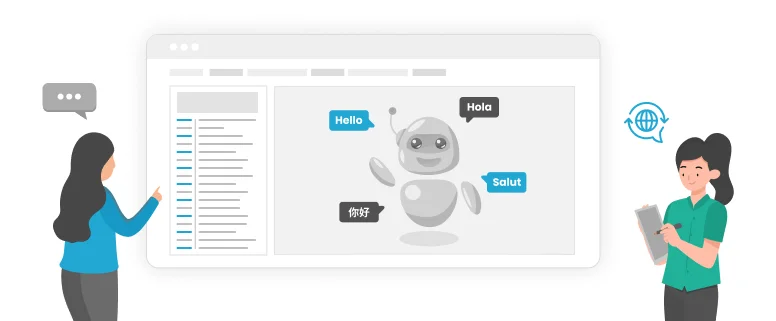Close your eyes and imagine that you’ve launched a software in your native country. The software becomes a hit in your home country. However, when you try to expand your software overseas it tanks, but how come? Well, there is a strong possibility it is because your software was not localized. People did not understand your software due to communication barriers, confusion, or poor user interface.
To mimic the success you achieved in your native country, you might want to consider finding the best software localization services. Such service providers are seasoned professionals who understand how to cater to various audiences based on their preferences, language, and more.
Let us dive deeper into the topic:
What is Software Localization?
Software localization is a process by which your software is adapted to suit the needs of a specific market, region, or population. Localization ensures that your software resonates with the local culture, preferences, and language. You can say that localization is the bridge that carries your software from local to international routes. It is the most important form of software translation solutions available. All major software companies utilize this strategy to grow their global presence.
Key Features of Software Localization
One of the main features of localization is translation. It is also the most prominent of all the features, but localization goes well beyond simple mere translations. Effective software localization requires planning, methodology, and execution. You need to be wary of all aspects if you want to break into new markets with success. Here are some of the main features of software localization:
Adaption of Culture
Culture plays a huge role in engaging foreign markets. African markets and Asian markets are especially influenced by their religious and cultural heritage. Understanding popular culture is a vital part of adaption, as that is most likely to elicit a positive response. Nuances of culture also play a special role in engaging your target audience. You do not want to upset or offend your audience in any way now do you?
Translation of Language
All the elements that contain texts need to be translated. This includes everything from the menu, button, documentation, messages, and more. Even your website needs to be available in different languages to ensure that all your target audiences have access.
Adapting Cultural UI
This form of adaption involves being ready to change content, images, symbols, colors, currency formats, date formats, and more. Be sure to add local payment options and methods to ensure better retention.
UI & UX Features
The layout of your application and website needs to be adjusted to suit the target market’s preferences. For instance, some cultures are used to a left dominated button settings, while some are used to the right dominated button settings.
Regulatory and Legal Compliance
Software translation solutions include legal compliance with your software. This includes privacy regulations, data protection, and other various features that are specified to a region.
QA Testing
Once your software is localized, it is then tested by locals from target audiences and industry professionals. Everything from translations to functionality of the application is tested before the market launch phase.
International Expansion and Software Localization
Any ambitious firm or individual sees international expansion as an exciting new prospect. Moving into a new region or market means a spike in the number of users. This can translate to more subscriptions, AdSense earnings, awareness, or more of whatever your general goal is. Localization for international expansion will increase your chances of monetization, building a community, and more.
Let us delve into some of these exciting opportunities presented by software translation solutions:
Larger User base
Localization gives your software a more native, presentable feel. Especially, with the induction of the target audiences’ native language, you are likely to have more people trying your software. Firstly, the translations will allow for better reach in the new regions, and secondly, because those who couldn’t understand your software at first, now can. You will have a larger user base to work with. The more regions you localize for, the larger your target audience gets.
Improved User Experience
Localization goes beyond just translation. As mentioned above, it involves adapting date and time formats, currency symbols, measurement systems, and even humor or images that relate to the target audience. This creates a seamless and positive user experience. The better user experience your software provides, the more are your chances of making your mark in a foreign land.
Enhanced Brand Reputation
Localization shows you respect your target audience and their culture. Global culture now demands the inclusion of everyone, through any means. Hence, this builds trust and fosters a positive brand image on the international stage.
Boosts Market Growth
By making your software accessible to a wider audience, localization unlocks new markets and revenue streams. It allows you to tap into various forms of monetization in the international market.
Here’s the catch: successful localization requires planning. There are two key steps
Internationalization (i18n)
This involves designing your software from the ground up to be adaptable to different languages and cultural norms. This includes using separate code for text, supporting various character sets, and building a flexible UI.
Localization (L10n)
Once your software is internationalized, you can localize it for specific markets. This involves translating text, adapting visuals, and ensuring cultural appropriateness.
Some Popular Localized Apps
Currently, many applications are localized and used by the global population. The localization strategy is so well planned that many do not even realize they are using foreign software.
Here are some of them:
- Microsoft Office Suite
- Google Workspace
- Apple
Final Thoughts
Software localization is a proven approach to successfully launch your software in foreign markets. It enables global companies to significantly optimize their software user experience and maximize downloads internationally. Localization helps software developer companies eliminate language barriers, and enhances software usability for diverse user bases. You must do extensive market research to develop a solid software localization strategy that will drive results. A professional localization company with specialized knowledge and advanced tools can support you to better plan and execute your localization strategy for new markets.



